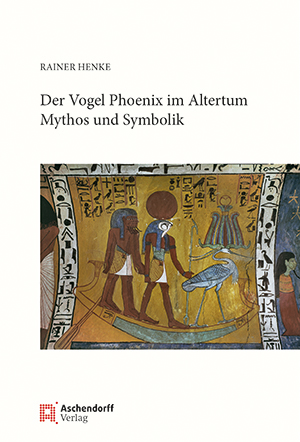Der Vogel Phönix im Altertum: Mythos und Symbolik
The Bird Phoenix in Antiquity: Myth and Symbolism
L'oiseau phénix dans l'Antiquité : mythe et symbolisme
El Ave Fénix en la antigüedad: Mito y simbolismo
The Bird Phoenix in Antiquity: Myth and Symbolism
L'oiseau phénix dans l'Antiquité : mythe et symbolisme
El Ave Fénix en la antigüedad: Mito y simbolismo
Münster: Aschendorff 2020,
XVI und 954 Seiten, 25 Seiten farb. Bildanhang ---
ISBN 978-3-402-24602-3
>>> English translation
at the end of the German information
>>>Traduction française
au bout de l'information allemande
>>>Traducción español
al final de la informción alemana
>>> English translation
at the end of the German information
>>>Traduction française
au bout de l'information allemande
>>>Traducción español
al final de la informción alemana
Verlagsinformationen
Ausgehend von den Anfängen im Alten Ägypten (Benu-Vogel) wird in diesem Buch der Phönix-Mythos sowie seine Verbreitung in den verschiedenen Kulturräumen über die hellenistische und römische Epoche bis hinein in die imperiale Nachblütezeit erörtert. Somit liefert es einen ganzheitlichen Überblick über die antike Entstehungsgeschichte und Verwendung dieses Mythos.
Dabei untersucht der Autor den Ursprung des griechischen Begriffs ,Phoinix‘ und die erste Schilderung des Phönix bei Herodot. Weiters wird die Verarbeitung des Stoffes bei dem jüdischen Bibel-Dramatiker Ezechiel beschrieben, außerdem ein besonderer Überlieferungsstrang des Mythos in der Naturgeschichte des Älteren Plinius sowie die Entfaltung der Sage in den Metamorphosen des römischen Dichters Ovid und bei dem Epigrammatiker Martial, der zuerst die Vorstellung vom „Phönix aus der Asche“ geprägt hat.
Eine neue Stoßrichtung gewinnt das Mythem vom Phönix sodann im jungen Christentum. Am Schluss stehen zwei wirkmächtige Dichtungen über den Phönix aus spätantiker Zeit, die sorgfältig verglichen und in ihrem geistesgeschichtlichen Kontext verortet werden.
Den originalen Textpassagen sind deutsche Übersetzungen beigegeben.
Neben den literarischen Zeugnissen werden die paganen und christlichen Bilddokumente einer eingehenden Prüfung unterzogen. Ein umfangreiches Gesamt-Register (Personen, Sachen, Orte, Begriffe, Tiernamen, Stellen) schlüsselt den Inhalt der vorliegenden Abhandlung für die Leser bequem auf.
Dabei untersucht der Autor den Ursprung des griechischen Begriffs ,Phoinix‘ und die erste Schilderung des Phönix bei Herodot. Weiters wird die Verarbeitung des Stoffes bei dem jüdischen Bibel-Dramatiker Ezechiel beschrieben, außerdem ein besonderer Überlieferungsstrang des Mythos in der Naturgeschichte des Älteren Plinius sowie die Entfaltung der Sage in den Metamorphosen des römischen Dichters Ovid und bei dem Epigrammatiker Martial, der zuerst die Vorstellung vom „Phönix aus der Asche“ geprägt hat.
Eine neue Stoßrichtung gewinnt das Mythem vom Phönix sodann im jungen Christentum. Am Schluss stehen zwei wirkmächtige Dichtungen über den Phönix aus spätantiker Zeit, die sorgfältig verglichen und in ihrem geistesgeschichtlichen Kontext verortet werden.
Den originalen Textpassagen sind deutsche Übersetzungen beigegeben.
Neben den literarischen Zeugnissen werden die paganen und christlichen Bilddokumente einer eingehenden Prüfung unterzogen. Ein umfangreiches Gesamt-Register (Personen, Sachen, Orte, Begriffe, Tiernamen, Stellen) schlüsselt den Inhalt der vorliegenden Abhandlung für die Leser bequem auf.




Keine Kommentare:
Kommentar veröffentlichen